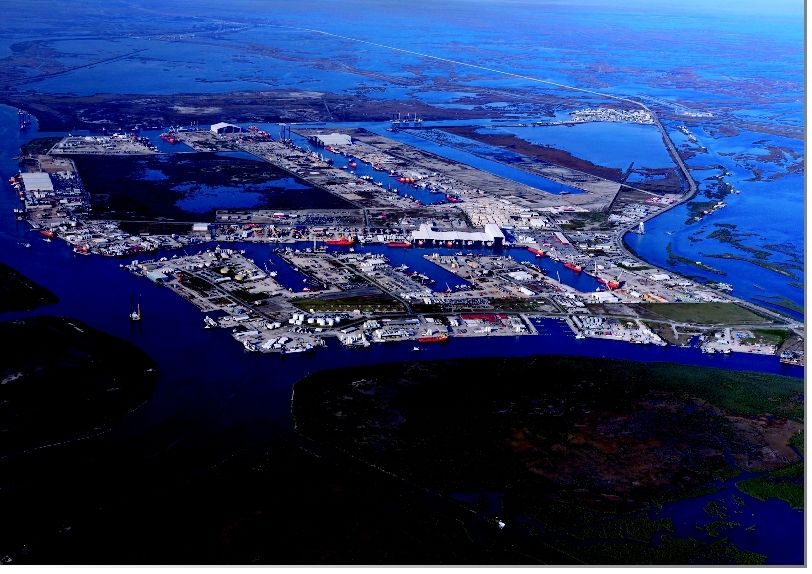Toll lane to close Thursday
January 28, 2015
HEART OVER HYPE
January 29, 2015A recent study and reports of progress on several fronts establish the continued importance of the Bayou Region’s ports to local communities and their commerce, even in the face of a downward oil-price slide, administrators and economic experts maintain.
At the Port of Terrebonne, accommodations for new tenants are underway
Government agencies leasing docks and offices through the General Services Agency should be complete by the end of 2015. Final negotiations are underway with a new commercial tenant whose name has not yet been announced. And efforts to have the Houma Navigational Canal routinely dredged to its fully authorized depth of 15 feet throughout continue.
Terrebonne Port Director David Rabalais said the oil price issue is a concern, but at this point not placing ports in crisis.
“It all depends on how long it lasts,” he said. “This area has experienced this sort of stuff four or five times in the last 30 or 40 years. It’s a matter of how long it lasts or how deep it goes. What’s going to happen next, it’s too early to see in terms of drastic changes.”
At Port Fourchon, meanwhile, construction and expansion continue, adding to the major impact it has already had on Lafourche, Terrebonne and the state.
Economist Loren Scott’s analysis of Port Fourchon’s economic impact, which was published last year, showed that entity accounting for more than $2.8 billion in sales revenue and more than $650 million in household earnings in 2013, with that impact branching throughout the state.
Scott’s report estimates the port’s job impact to Louisiana for 2013 at 10,804.
“For every one job created in Port Fourchon, another 5.2 jobs are created elsewhere in the state’s economy to support it,” he told members of the Greater Lafourche Port Commission.
The study also found that one in every 13 jobs in Lafourche and Terrebonne is directly related to that port.
“What is most encouraging to see is that of all our tenants are investing and earning through their work at Port Fourchon, about 80 percent of it stays right here in our community, providing billions in revenue, household earnings and local taxes to the residents of Lafourche and Terrebonne,” Port Director Chett Chiasson said.
“We have seen the port grow physically in recent years, adding over 50 percent more acreage through our Northern Expansion, and this study shows how much our tenants have done with that new space to continue to grow our community’s economy and help us fulfill our mission,” said Port Commission Board President Perry Gisclair.
Scott’s report showed tremendous growth over the period 2009-13, creating $570 million in new sales throughout the Houma Metropolitan Statistical Area. An MSA is an area defined by the U.S. Office of Management and Budget for statistical and record keeping purposes. The Houma-Bay-ou Cane-Thibodaux MSA is comprised of the parishes of Terrebonne and Lafourche.
Other effects of the port included in the Scott report:
• $194.8 million in new household earnings for residents of the area.
• An average of 708 jobs a year for MSA residents.
• $2.1 billion in sales.
• $458.1 million in household earnings.
• Jobs with annual wages 27 percent higher than the average annual wage in Louisiana.
• $12.8 million in sales taxes.
Fourchon’s strategic location and accommodations have placed it in the role of servicing an estimated 90 percent of the oil and gas exploration activity around the Gulf of Mexico.
Operations include being host port to the Louisiana Offshore Oil Port.
The Port of Terrebonne has its own unique characteristics that have placed it in what boosters say is a winning position.
Financial reports filed in 2014 show the Port of Terrebonne’s assets well exceeding its liabilities, to the tune of more than $78 million. Capital projects got a leg up from nearly $9 million pumped in from federal and state sources.
The Fourchon and Terrebonne ports have different issues to deal with, and so their best paths toward a secure future differ as well.
Unlike Fourchon, whose legal jurisdiction is limited largely to its docks and wharves, the Terrebonne port is legally defined not only as the campus wedged between Industrial Boulevard and the Houma Navigational Canal but every dock or slip on every waterway within Terrebonne Parish.
That’s important because the port’s national ranking is determined on the tonnage of cargo loaded or off-loaded. Completed vessels at shipbuilding outfits, oilrigs fitted at a plethora of private businesses and oilfield food, tools and other materials all are counted in the equation.
For decades the port had not taken full advantage of that formula and, over the past year, Rabalais has been educating marine companies about their responsibility to report what they float, load and receive on the waterways.
Extensive research by Terrebonne Port director revealed that proper reporting can vastly improve the port’s standing when it comes to the frequency of dredging for the Navigational Canal.
“We are authorized to a depth of 15 feet,” Rabalais said, but a scarcity of federal resources has resulted in priority being given to other ports.
The formula developed by Rabalais, largely with the help of former U.S. Sen. Mary Landrieu, has resulted in a rank of 86th out of 150 U.S. ports, qualifying it for more attention.
U.S. Sen. David Vitter (R-La.) has assisted with many aspects of the port’s growth, and Rabalais says he is looking forward to working with U.S. Sen. Bill Cassidy (R-La.) on future projects.
A major priority for Raba-
Lais is a proposed clarification in federal regulations that will allow seafood Landings within the port’s jurisdiction – the entire parish – to be counted as cargo.
If that is accomplished, Rabalais said, the port’s national standing will get a big boost.
Estimated 2013 seafood Landings for last year in Terrebonne well exceeded 100 million metric tons, according to federal data.
“It’s documented by the Department of Wildlife and Fisheries so it shouldn’t be difficult for the Department of Waterborne Commerce to get the data,” Rabalais said. “It’s cargo, we bring it up and down our channels. There are a few things we need to tweak and fine tune.”
The move toward housing vessels and offices for U.S. Immigration and Customs Enforcement and U.S. Customs and Border Protection is nearly complete, and will add to the revenue stream, Rabalais said.
“Customs is finished, ICE will be underway by the end of the year,” he said.
The Louisiana Department of Transportation and Development is partnering with the U.S. Army Corps of Engineers to schedule the needed channel dredging, meanwhile, to guarantee the port is able to keep the clients it gets.
The final 12 miles of the canal leading to the port is crucial, Rabalais said; currently some areas of the aquatic highway are silted to depths of 12 and 13 feet, making navigation a chore for some vessels.
Ideally, Rabalais would like to see authorization for dredging to 20 feet, but that won’t be a real possibility for now.
“So long as we can keep it at the authorized 15 feet we’ll be happy,” he said. “We’ve got to keep it at 15 feet.”
Port Fourchon (pictured) has continued to grow in recent years as work in the Gulf of Mexico has continued to soar. Over in Terrebonne, things have been the same, as the Port of Terrebonne also experiences growth and expansion efforts.
The Port of Terrebonne has enjoyed a nice 2014, and is hopeful for continued growth in the next year.














